
Best Exercises for Tennis Players
Leave a CommentInjury risk is a reality of any sport, and tennis is no different. More than 41 percent of elite tennis players lose time from play and practice due to injuries related to the sport. Adolescent tennis players are at greater risk of injury when there has been a previous injury sustained.5,6 Overall, two-thirds of tennis injuries are caused by overuse.
For tennis players, incorporating a few simple exercises into their daily routines can help decrease the risk of injury in tennis and help resolve aches and pains experienced on the court. Listed below are a few suggestions of important exercises for tennis players:
1. Plank
A strong core (the inner abdominal muscles that support your spine) plays a valuable role for tennis players, as the core helps generate power and stability while playing tennis. Research also shows that a strong core can decrease the risk of shoulder pain in tennis players.4
- While lying face down, lift your body up on your toes and forearms.
- Keep your shoulders, back and hips in a straight line.
- Hold for 30 seconds, repeat three times.
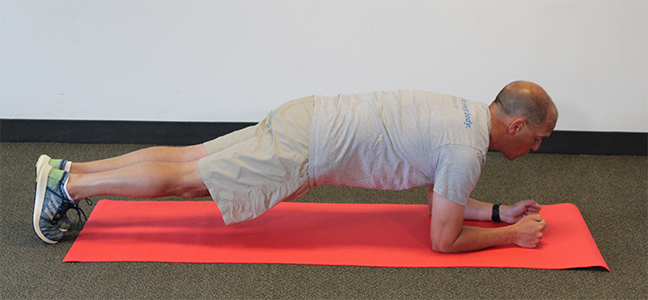
2. Posterior Capsule Stretch
Stiffness in the back of the shoulder is a common adaptation seen in the dominant arm in tennis players. This leads to decreased ability to reach across the body and rotate the arm inward. Studies have shown that posterior shoulder stiffness can lead to shoulder inflammation and injury.1
- Prior to starting this stretch, assume a position of good posture by squeezing the shoulder blades together without hiking up the shoulders. While maintaining this position, reach arm across body while using other arm to push elbow toward the opposite shoulder.
- Hold for 30 seconds, repeat three times.
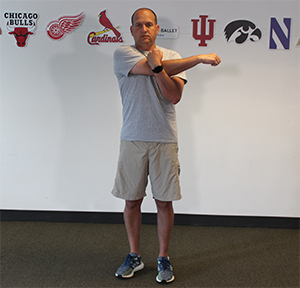
3. Hip Flexor Stretch
Due to the repetitive motions required in tennis, the hip musculature can get tight and place increased strain on the back, hips and knees. This is a great stretch to keep the hips loose and decrease strain on the back.
- Kneel on the floor and maintain an upright trunk during the entire stretch.
- While kneeling, lunge forward until you feel a stretch along the front of the hip and thigh. Continue maintaining your trunk upright and avoid arching your back.
- Hold for 30 seconds, repeat three times on each side.
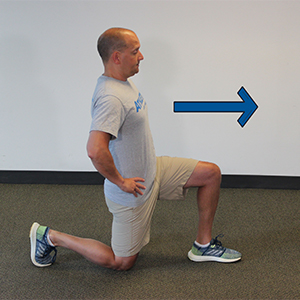
4. Resisted External Rotation at 90 Degree Abduction
This exercise is essential for stabilizing the shoulder with overhead activity. If the rotator cuff muscles of the shoulder are weak, there may be an increased risk for shoulder pain in tennis players. These muscles are often weak in athletes with current or a previous history of shoulder pain.7
- Securely tie an elastic band to a stable surface at shoulder height.
- Hold arm out to side with the elbow bent at 90 degrees, maintaining the shoulder and elbow in a straight line.
- Start with arm pointing forward and rotate arm up toward ceiling.
- Perform three sets of 10 repetitions.
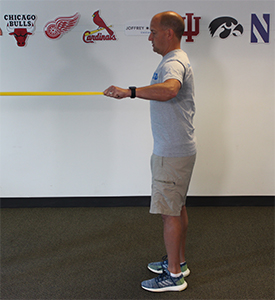
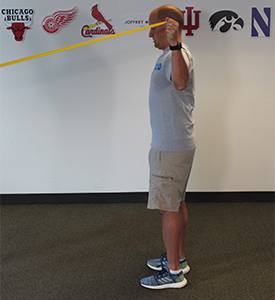
5. Squat with Overhead Press
Strength and power in the legs and trunk are key for force development during tennis. The lower body and trunk has been shown to contribute 51-55 percent of the force delivered to the hand during tennis.4
- Start in a squat position with arms at the side. Make sure that you are sitting back as if you are sitting in a chair. This will help prevent your knees from going over your toes, which can cause knee pain. Stand up out of the squat and press arms toward the ceiling. Make sure your shoulders are not shrugging up as you reach your arms overhead to prevent neck and shoulder injury.
- Return arms to your side as you return to the squat position.
- Perform three sets of 10 repetitions.
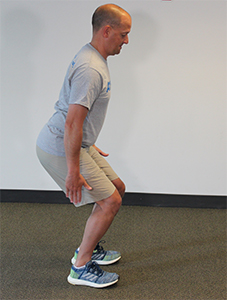
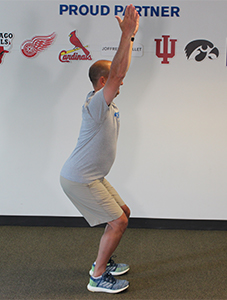
Perform Your Best on the Court
Should pain or injury occur while on or off the court, schedule a free assessment at a nearby Athletico clinic so our experts can provide recommendations for treatment.
Athletico’s Sports Edge Tennis Assessments are also available at our Lincoln Park North clinic. These assessments thoroughly evaluate the strength, mobility and tennis-specific movements required to stay injury free and return to a higher level of performance following injury. Contact LincolnParkNorth@athletico.com for more information.
The Athletico blog is an educational resource written by Athletico employees. Athletico bloggers are licensed professionals who abide by the code of ethics outlined by their respective professional associations. The content published in blog posts represents the opinion of the individual author based on their expertise and experience. The content provided in this blog is for informational purposes only, does not constitute medical advice and should not be relied on for making personal health decisions.
References:
1. Cools AM. (2015). Prevention of shoulder injuries in overhead athletes: a science-based approach. Braz J Phys Ther. Sept-Oct,19(5), 331-339
2. Hjelm N. (2010). Injury risk factors in junior tennis players: a prospective 2 year study. Scand J Med Sci Sports, 22, 40–48.
3. Elliott B. (2003). The development of racquet speed. In: Elliott B, Reid M, Crespo M, eds. Biomechanics of advanced tennis. London: International Tennis Federation 2003. p33-47.
4. Kibler WB. (1995). Biomechanical analysis of the shoulder during tennis activities. Clin Sports Med,14, 79-86.
5. Kibler WB. (2003). Rehabilitation of rotator cuff tendinopathy. Clin Sports Med, 22, 837–847.
6. Kibler, Ben. “The Kinetic Chain in Tennis.” Aspetar Sports Medicine Journal, www.aspetar.com/journal/upload/PDF/2013112415533.pdf.
7. https://www.aspetar.com/journal/upload/PDF/2013112415533.pdf7. Moreno-Perez V. ,(2016). Descriptive profile of hip range of motion in elite tennis players. Physical Therapy in Sport 19, 43-48.
